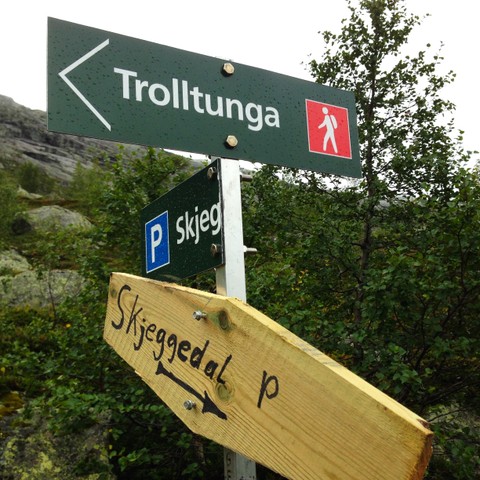Trekking excursion to the Trolltunga, Norway
Trolltunga is a natural rock ledge that hangs from a mountain with a free fall of over 700 meters. It's one of the most spectacular viewpoints in the world.
By @charlie_nomade - 21/Nov/2022
Picture: @charlie_nomade

Duration: Trek 22km– round trip (10-11 hours)
Level: Mid-high
Season: Summer / jun-sep (8 / 16 ºc)
How to visit the Trolltunga?

The Trolltunga is located in the Hordaland region, about 11 kilometers away from the municipality of Odda. The starting point for the hike is the Skjeggedal car park. Getting to Trolltunga will depend on the city we arrive in Norway and the type of transportation we use. The closest airport is in Bergen, and from there, the route consists of two buses and a ferry, taking a total of 3 hours. The transportation website skyss.no provides detailed information about tickets, schedules, and routes throughout Norway.
In our case, we traveled by rental car from Oslo, which took about 6 hours to cover 360 kilometers. In Norway, the roads are often situated between mountains with tunnels and many curves.

If you're traveling by car, I recommend doing what most people do, going directly to the Skjeggedal car park from where the trek begins. It's best to sleep in the car to avoid complications since you need to start walking very early (the trek is about 10-11 hours round trip), so you'll still have light when you return. Alternatively, you have two options: if you have camping equipment (note that free camping in Odda municipality is prohibited), you can go to Odda Camping and take the early morning bus to Skjeggedal.
By the way, if you're traveling by car, don't forget to purchase a ticket for the Skjeggedal Car Park parking meter before starting the hike.
Equipment and supplies for the Trolltunga
To go on this excursion, we'll need to travel light and wear good trekking shoes with a lot of grip. It's also essential to bring a sweater, a raincoat, or a waterproof jacket, and a small backpack to carry food for the day and a refillable water bottle. You'll find springs along the way to refill your water bottle. Additionally, you can consider taking walking sticks to help with your knees, especially for the descent.
On the way to the Trolltunga
The path to the Troll's Tongue is divided into four stages that are clearly distinguished by their changes in relief. It starts from the car park next to the funicular that hasn't been working for years, and it takes about 45 minutes of climbing through wooded terrain on a very steep, vertical slope that leads us to an esplanade with some refuge-type houses. Here, we begin to see signs that indicate the remaining distance, as well as rocks marked with graffiti that have the symbol "T," which will guide us.

As we continue, the slopes become steeper, and the terrain changes to solid gray rock that is wet with dew. We are practically alone, except for a couple of people in the distance who show clear signs of fatigue, and four or five more people in various groups behind us. However, nobody speaks. Up here, silence is our best company.
An hour later, we will reach another welcome esplanade, covered in a mixture of grass and moss, which provides some rest for our legs. There are also small lakes, formed by the rains, where we can cool our faces a bit.
In another hour and a half, we will find ourselves climbing a gentle slope on muddy ground. We must pay special attention to the small rocks on which to lean, so we don't end up with mud up to our ankles. In the background, we can begin to see mountains with glaciers and tongues of snow at the top.

After an hour, the dangerous section begins. This route follows the edge of cliffs but offers incredible views of Lake Ringedalsvatnet. Suddenly, we find ourselves enveloped by a thick blanket of fog that limits our visibility. We immediately stop walking and sit down, trying to remain calm and wait for the fog to clear. On several occasions, my eyes trick me into thinking that I see motionless figures in the fog, creating a strange sensation. After half an hour, the fog dissipates, and we resume our journey.
The signs indicate that we have a few kilometers left, and the fatigue takes a back seat as we know our reward is close. The last stage is smooth, with solid gray rock under our feet and a few small waterfalls where we can refill our water bottles. Suddenly, we spot a group of people on the horizon, and we realize that we have arrived at our destination. We pick up the pace, and in 15 minutes, we are there, enjoying one of the most spectacular and privileged views in the world. The Trolltunga protrudes at over 700 meters high, a giant tongue made of stone, defying gravity in its capricious form.
Tips
A tradition when returning from the Trolltunga is to put your feet in the icy lake water on the other side of the parking lot and hold on as long as possible. I was only able to last a few seconds, as it felt like being pricked with a thousand needles.